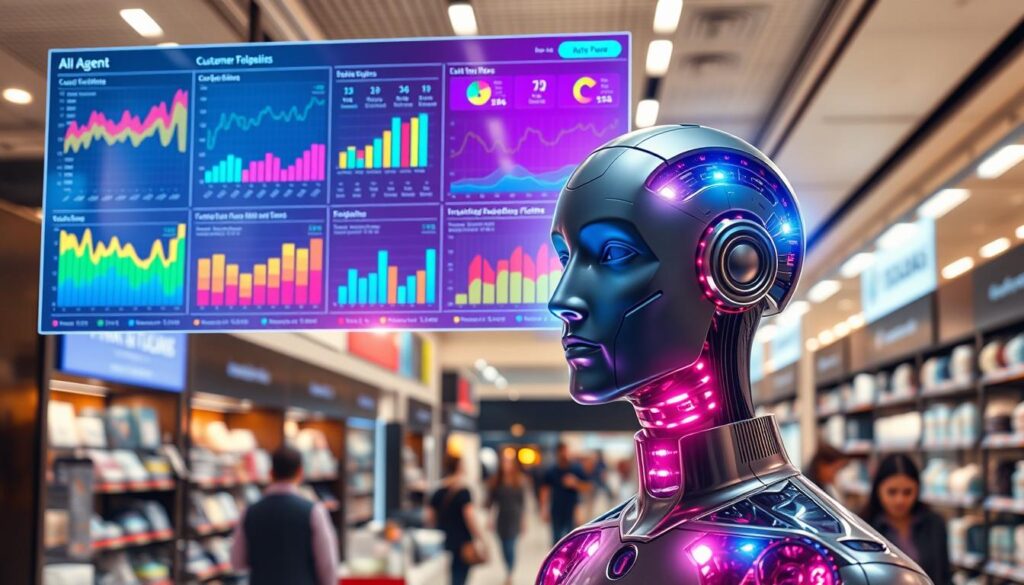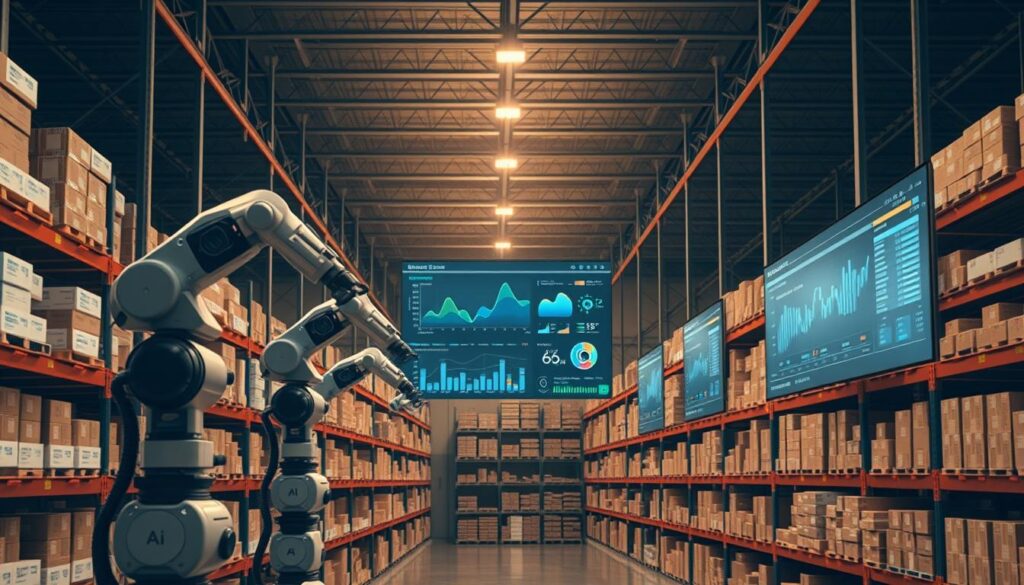“The future of retail is not just about selling products; it’s about creating meaningful experiences.” – This quote by a leading industry expert captures the essence of the ongoing transformation in e-commerce. Today, technology is redefining how businesses interact with their customers, making the shopping journey more personalized and efficient.
AI-driven tools are revolutionizing the retail landscape. From predicting customer preferences to managing inventory in real time, these innovations are enhancing the shopping experience. For instance, 69% of retailers report significant revenue growth due to AI integration1. This highlights the growing importance of leveraging technology to meet customer expectations.
Businesses are also using AI to automate tasks like personalized promotions and cart abandonment outreach, saving valuable time1. As a result, customers enjoy a seamless experience, while retailers benefit from improved operational efficiency. The future of e-commerce lies in harnessing these advancements to create a more connected and customer-centric marketplace.
Key Takeaways
- AI enhances the shopping experience by personalizing recommendations and optimizing inventory.
- Retailers using AI report significant revenue growth, showcasing its business impact1.
- Automation of tasks like promotions and cart outreach saves time and improves efficiency1.
- Real-time inventory updates ensure accurate product availability across all channels1.
- AI-driven tools help businesses meet evolving customer expectations effectively.
Introduction to AI Agents in E-commerce

Intelligent systems are transforming retail operations by acting as digital copilots. These systems enhance both online and physical shopping experiences, making them more efficient and personalized. They analyze datum to deliver tailored recommendations, ensuring customers find what they need quickly2.
Defining Intelligent Systems and Their Role
Intelligent systems are advanced tools designed to automate and optimize retail tasks. They handle everything from customer service to inventory management. For example, chatbots provide 24/7 support, resolving queries instantly2. This allows human agents to focus on complex issues, improving overall efficiency.
The Evolution of Intelligent Systems in Retail
The adoption of intelligent systems began in 2016, with chatbots handling common queries2. Since then, these tools have evolved to include dynamic pricing models and predictive analytics. By 2032, the market for these systems is expected to reach $45.72 billion3. This growth highlights their importance in modern business strategies.
Retailers using intelligent systems report significant improvements in customer satisfaction and operational efficiency2. These tools also help businesses comply with data protection regulations, ensuring customer trust2. As the retail landscape continues to evolve, intelligent systems will play a crucial role in shaping its future.
Transforming the Shopping Experience

Retailers are leveraging advanced tools to create smoother, more personalized shopping journeys. These innovations focus on understanding customer behavior and eliminating friction at every touchpoint. By analyzing browsing and purchase history, businesses can deliver tailored product suggestions that resonate with individual preferences4.
Personalized Product Recommendations
Modern systems use machine learning to analyze vast amounts of data, providing valuable insight into customer preferences. For example, platforms like Amazon suggest items based on previous purchases, increasing the likelihood of a sale5. This approach not only boosts conversion rates but also enhances customer satisfaction.
Personalized recommendations can drive up to 35% of total online sales, showcasing their impact on revenue5. By understanding customer needs, retailers can create a more engaging and efficient shopping experience.
Seamless In-Store and Online Navigation
Conversational tools and self-checkout systems are eliminating friction in both physical and online stores. These solutions simplify the shopping process, allowing customers to complete their tasks quickly and effortlessly4.
For instance, AI-driven kiosks reduce wait times, while chatbots assist with tracking orders and answering product questions4. This seamless navigation ensures a positive experience, encouraging repeat purchases and loyalty.
Retailers adopting these technologies report higher customer satisfaction and increased sales, proving the value of intuitive navigation4.
How AI Agents Are Shaping the Future of E-commerce

Retail innovation is accelerating with the integration of advanced technologies. These tools are transforming how businesses interact with customers, making experiences more personalized and efficient. By leveraging data-driven insights, retailers can anticipate needs and deliver tailored solutions.
Predictive Analytics for Tailored Promotions
Modern systems analyze vast amounts of customer datum to generate personalized promotions. For example, machine learning algorithms identify purchasing patterns and suggest relevant discounts. This approach increases conversion rates by up to 20% compared to traditional methods6.
Predictive analytics also help retailers forecast demand, ensuring products are always available. This reduces out-of-stock occurrences by 30%, improving customer satisfaction6. By understanding consumer behavior, businesses can create targeted campaigns that resonate with their audience.
Real-Time Decision Making in Retail
Real-time systems enable retailers to adapt quickly to market trends. For instance, dynamic pricing models adjust prices based on demand and competitor strategies7. This ensures businesses remain competitive while maximizing profits.
These solutions also streamline inventory management, minimizing errors and optimizing stock levels7. By automating routine tasks, retailers can focus on strategic initiatives, driving growth and efficiency.
As the retail landscape evolves, integrating machine learning into operations will become essential. These technologies not only enhance customer experiences but also prepare businesses for the future of commerce.
Enhancing Inventory Management and Pricing Strategies

Technology is reshaping how businesses manage inventory and pricing, ensuring better outcomes for both retailers and shoppers. By leveraging advanced tools, companies can optimize stock levels and adjust pricing dynamically, maximizing revenue and customer satisfaction.
Optimizing Stock Levels with Predictive Insights
Predictive analytics plays a crucial role in inventory management. These tools analyze historical sales data and market trends to forecast demand accurately8. This helps businesses avoid overstocking and stockouts, ensuring products are always available for the shopper.
For example, Walmart achieved a 15% reduction in inventory levels through AI optimization9. Automated replenishment systems also ensure optimal stock levels without manual intervention, improving cash flow and operational efficiency8.
Dynamic Pricing Models Driven by AI
Dynamic pricing strategies adjust in real-time based on market demand and competitor data. These models maximize revenue by offering the right price at the right time8. For instance, major retailers like Amazon use AI-driven pricing to stay competitive and improve profit margins9.
This approach not only benefits businesses but also ensures fair pricing for the shopper. By integrating these strategies, companies can respond quickly to market changes, enhancing their competitive advantage8.
In summary, the use of advanced technology in inventory and pricing strategies is transforming retail operations. These innovations improve efficiency, reduce costs, and create a better experience for the shopper.
Augmenting Customer Support with AI Chatbots

Customer support is evolving with the integration of intelligent systems, offering round-the-clock assistance and seamless interactions. These tools are transforming how businesses interact with their customers, ensuring quick and efficient resolutions to queries.
Chatbots provide immediate support by handling a wide range of inquiries without downtime. For example, brands like SEPHORA use these systems to streamline support processes, ensuring customers receive timely assistance10. This automation reduces the burden on human teams, allowing them to focus on complex issues.
24/7 Automated Assistance
One of the standout features of chatbots is their ability to operate 24/7. This ensures customers can get help at any time, significantly improving satisfaction levels10. Automated systems also manage orders and provide personalized product recommendations, enhancing the overall shopping experience.
Integrating these tools into online platforms helps businesses manage customer interactions more effectively. For instance, chatbots can gather information for issues requiring human expertise, facilitating smoother escalations10. This seamless integration ensures high service levels while maintaining efficiency.
However, challenges like data privacy and system integration must be addressed. Ensuring compliance with regulations and maintaining secure platforms is crucial for building customer trust10. By overcoming these challenges, businesses can fully leverage the potential of intelligent chatbots.
For more insights on how these systems are transforming customer support, visit this detailed guide.
Driving Operational Efficiency and Data-Driven Decisions

Operational efficiency is at the core of modern commerce, driven by advanced tools. Businesses are leveraging these innovations to streamline back-end processes, enabling them to focus on strategic growth areas. By automating repetitive tasks, companies can allocate resources more effectively, ensuring smoother operations and better outcomes.
Automating Repetitive Tasks
Intelligent systems handle time-consuming activities like form filling and competitor pricing tracking. This automation reduces manual effort, allowing staff to concentrate on higher-value tasks11. For example, machine learning algorithms can analyze vast datasets, providing actionable insights that improve decision-making12.
Enhancing Commerce Operations
Machine learning plays a pivotal role in analyzing customer and sales data. Retailers use these insights to optimize product listings and improve customer service11. For instance, AI-driven tools can predict demand patterns, ensuring optimal inventory levels and reducing waste12.
Real-Time Decision Support
AI assistants provide real-time insights, enabling businesses to make informed decisions quickly. These tools analyze multiple data points, such as sales trends and market conditions, to present actionable recommendations13. This approach not only enhances efficiency but also drives business growth.
By integrating these technologies, companies can achieve higher operational efficiency. For example, Walmart uses AI-powered analytics to track inventory in real-time, reducing waste and optimizing stocking strategies12. This demonstrates the transformative impact of data-driven decisions in modern commerce.
Future Trends in AI and Unified Commerce
The retail industry is on the brink of a technological revolution, with emerging innovations reshaping the shopping experience. From augmented reality to voice-enabled assistants, these advancements are redefining how customers interact with brands. By 2025, every digital touchpoint is expected to evolve into a revenue-driving opportunity, emphasizing the need for seamless integration of content and commerce14.
Integration with Augmented Reality and Voice Assistants
Augmented reality (AR) is transforming the in-store experience by enabling virtual try-ons. Shoppers can now visualize how an item will look or fit before purchasing, reducing returns and enhancing satisfaction15. For example, beauty brands like SEPHORA use AR to allow customers to test makeup virtually, creating a more engaging shopping journey.
Voice assistants are also gaining traction, offering effortless command-based purchases. While only 2% of customers currently use voice shopping, this percentage is projected to rise as interactions become more intuitive and trusted14. Platforms like Amazon Alexa and Google Assistant are leading the charge, enabling users to reorder products or check store availability with simple voice commands.
The Rise of Unified Commerce
Unified commerce connects all systems and data, ensuring a cohesive experience across channels. This approach allows retailers to deliver consistent messaging, whether a customer is shopping online, in-store, or via social media. Omnichannel selling is projected to be a necessity for growth, as consumers demand seamless interactions14.
For instance, brands like Zara use advanced tools to manage inventory across physical and online stores, ensuring products are always available15. This integration not only improves efficiency but also builds trust and loyalty among shoppers.
The Role of Cross-Functional Teams
Implementing these innovations requires collaboration across departments. Cross-functional teams leverage AI-driven tools to enhance service and product integration. By combining expertise from marketing, IT, and customer support, businesses can create solutions that meet evolving consumer needs14.
For example, AI-powered analytics help these teams predict trends and optimize operations, ensuring a competitive edge. As the retail landscape evolves, these strategies will be crucial for delivering personalized and efficient experiences.
Navigating Challenges in AI Integration
Integrating advanced technologies into retail comes with its own set of challenges. While these tools promise efficiency and innovation, businesses must address critical issues to ensure successful implementation. From privacy concerns to technical expertise, overcoming these hurdles is essential for long-term success.
Privacy, Security, and Customer Trust
Data privacy is a top concern for businesses adopting new systems. Customers expect their information to be handled securely, especially in online shopping environments. For example, compliance with regulations like GDPR and CCPA is essential to maintain trust16.
Transparency in how data is used can build customer confidence. Retailers must ensure that chatbot interactions and other tools respect privacy. Failure to do so can lead to reputational damage and loss of trust16.
Managing Costs and Technical Expertise
High initial costs are a significant barrier for many businesses. Smaller retailers, for example, may struggle to afford the setup and maintenance of advanced systems16. Additionally, the shortage of skilled professionals adds to the challenge.
Investing in training and partnerships can help bridge the gap. Over time, these efforts can reduce costs and improve efficiency. For instance, automating repetitive tasks with chatbots can free up resources for strategic initiatives17.
Despite these challenges, the benefits of integration are undeniable. Retailers that address these issues early can gain a competitive edge. By focusing on privacy, cost management, and technical expertise, businesses can unlock the full potential of modern solutions.
Conclusion
The integration of advanced technologies has redefined the retail landscape, offering unprecedented opportunities for growth and efficiency. These systems enhance shopping experiences through personalized recommendations and dynamic pricing, while also streamlining back-end operations18. By leveraging predictive analytics and automation, businesses can make real-time decisions that drive both customer satisfaction and operational excellence.
Unified commerce plays a pivotal role in integrating these solutions across all channels, ensuring a seamless experience for shoppers. Companies that adopt these trends not only overcome operational challenges but also position themselves for long-term success19. For instance, AI-driven recommendation engines significantly increase product relevance, boosting conversion rates by up to 35%20.
As the retail industry evolves, embracing these innovations is no longer optional but a competitive necessity. Businesses that invest in automation and natural language processing will lead the way, delivering superior performance and meeting the ever-changing demands of modern consumers.
FAQ
What are AI agents in e-commerce?
How do AI agents improve the shopping experience?
Can AI agents help with inventory management?
What role do AI chatbots play in customer service?
How do AI agents impact pricing strategies?
What challenges come with integrating AI in e-commerce?
What future trends are expected in AI and e-commerce?
How do AI agents enhance operational efficiency?
Source Links
- The Future of Commerce: Unified and Augmented by AI Agents
- The future of e-commerce customer service: AI agents – E-commerce Germany News
- AI for Ecommerce: How It’s Transforming the Future
- How AI Agents in Retail Are Transforming E-commerce?
- How AI is Redefining E-Commerce and Personalized Shopping Experiences
- AI Shopping Agents Transform Online Shopping | Digital Experience
- AI: Shaping the Future of E-Commerce
- AI-Powered Inventory Management in Retail and E-commerce| 2024
- How AI is Shaping the Future of E-commerce Workflows – Dapta
- How Augmented AI is Shaping the Future of Customer Engagement
- How AI Agents Are Changing the Way We Work: A Business Leader’s Guide
- AI for Operational Efficiency: Benefits. Challenges & Use Cases
- How AI Agents Can Transform Supply Chain Decision-Making
- 8 Predictions for the Future of eCommerce in 2025: AI & Innovation
- AI Agents in Ecommerce: Application, Benefits and Challenges
- The Challenges Of AI For Ecommerce – SwiftERM AI Technology
- The AI Agent Revolution: Navigating the Future of Human-Machine Partnership
- How AI Agents Are Revolutionizing Content Writing
- Transforming E-Commerce: The Pivotal Role of AI Agents in Revolutionizing Online Retail
- How Generative AI Is Shaping the Future of E-commerce







